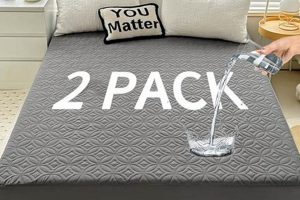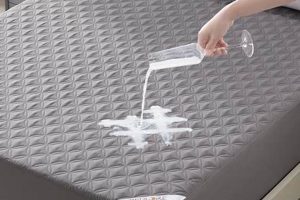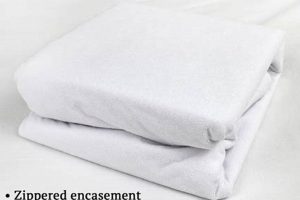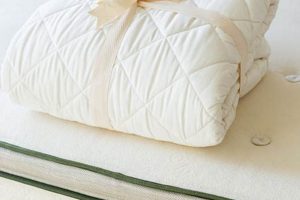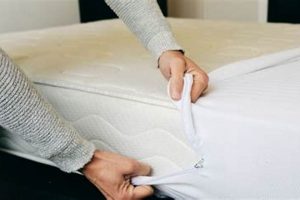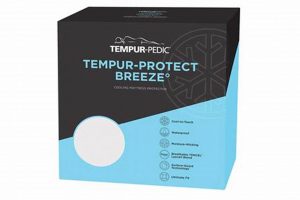The process of laundering a fabric covering designed to shield a bed’s sleeping surface from fluids, stains, allergens, and wear is a routine household task. This practice ensures hygiene and prolongs the lifespan of the underlying bedding. The frequency of this procedure often depends on usage and manufacturer recommendations.
Regular maintenance of this protective layer contributes significantly to a healthier sleep environment by mitigating dust mite infestations and preventing the build-up of bodily oils and spills. This practice can improve air quality within the bedroom and can reduce the potential for allergic reactions. Historically, such methods of maintaining bedding have been employed using rudimentary materials; modern textile technology has evolved these coverings to be easily removable and machine washable.
Understanding the specific material composition and care instructions is vital before initiating the cleaning process. This article will further examine appropriate cleaning methods, drying techniques, and considerations for handling various types of materials commonly used in these protective coverings.
Tips for Effectively Washing Mattress Protectors
Proper maintenance of mattress protectors is crucial for both hygiene and longevity. Adhering to best practices during the cleaning process ensures optimal performance and prevents damage to the material.
Tip 1: Consult the Care Label: Prior to initiating any cleaning, meticulously examine the manufacturer’s care label. This label provides specific instructions regarding water temperature, detergent type, and drying methods suitable for the protector’s material composition.
Tip 2: Pre-Treat Stains: Address any visible stains before placing the protector in the washing machine. Utilize a mild stain remover or a solution of diluted detergent applied directly to the affected area. Allow the solution to sit for approximately 15-30 minutes before washing.
Tip 3: Use Mild Detergent: Select a gentle, hypoallergenic detergent to prevent allergic reactions and to safeguard the integrity of the fabric. Avoid harsh chemicals, bleach, or fabric softeners, as these can degrade the protector’s waterproof or breathable properties.
Tip 4: Wash in Cold or Warm Water: Unless otherwise indicated on the care label, wash the protector in cold or warm water. High temperatures can potentially damage certain materials, causing shrinkage or delamination of waterproof layers.
Tip 5: Tumble Dry on Low Heat or Air Dry: Exercise caution when drying the protector. Tumble dry on a low heat setting to prevent shrinking or melting. Alternatively, air drying is recommended to further minimize the risk of damage and to extend the protector’s lifespan. Ensure the protector is completely dry before reapplying it to the mattress to prevent mold or mildew growth.
Tip 6: Avoid Overloading the Washing Machine: Ensure the washing machine is not overloaded to allow for adequate agitation and rinsing. Overcrowding can prevent the protector from being thoroughly cleaned and can potentially damage the machine.
Tip 7: Inspect for Damage: After washing, carefully inspect the protector for any signs of damage, such as tears, cracks, or delamination. Addressing these issues promptly will prevent further deterioration and maintain its protective capabilities.
By diligently following these recommendations, individuals can maintain the cleanliness and effectiveness of their mattress protectors, thereby promoting a healthier sleep environment and extending the lifespan of both the protector and the underlying mattress.
The following section will address specific considerations for different material types and frequently asked questions related to mattress protector maintenance.
1. Frequency
The frequency of laundering a mattress protector significantly impacts its effectiveness in maintaining hygiene and extending the lifespan of the mattress. Determining an appropriate washing schedule requires considering several interrelated factors.
- Usage Intensity
Mattress protectors in frequently used beds, such as those in master bedrooms or guest rooms with high occupancy, require more frequent washing. Daily use increases exposure to sweat, body oils, and allergens, necessitating a shorter cleaning interval, perhaps as often as monthly. Conversely, protectors on beds used infrequently may only need laundering every few months.
- Environmental Factors
The surrounding environment can influence the required washing frequency. Humid climates promote the growth of mold and mildew, increasing the need for more frequent laundering. Homes with pets or individuals with allergies may also warrant a more aggressive washing schedule to minimize allergen accumulation.
- Manufacturer Recommendations
Care labels provide specific guidelines from the manufacturer regarding recommended washing frequency. Adhering to these recommendations ensures the protector is cleaned appropriately without causing premature wear or damage to the materials. Deviating from these guidelines can void warranties or compromise the protector’s performance.
- Visible Soiling and Staining
The presence of visible stains, spills, or odors necessitates immediate laundering, regardless of the established washing schedule. Prompt cleaning prevents stains from setting and inhibits the growth of bacteria or mold. Ignoring visible soiling can lead to permanent damage to the protector and compromise its hygienic properties.
Ultimately, establishing an effective washing schedule for mattress protectors involves a balanced consideration of usage patterns, environmental conditions, manufacturer guidelines, and visual inspection. Regular adherence to a well-defined cleaning routine ensures the protector effectively maintains a hygienic sleep environment and extends the life of the mattress.
2. Water Temperature
The water temperature used during the process of laundering a mattress protector significantly impacts the outcome and longevity of the item. Exposing certain materials to excessively high temperatures can cause irreversible damage, including shrinkage, warping, and degradation of any waterproof or breathable membranes. Conversely, using water that is too cold may not effectively remove embedded dirt, allergens, or stains, rendering the cleaning process incomplete. For instance, washing a protector with a polyurethane waterproof layer in hot water often leads to delamination, compromising its protective function. Conversely, washing a heavily soiled protector at a water temperature below 30C may fail to dislodge greasy residues. Selecting the correct water temperature is therefore essential to preserve both the integrity and hygienic properties of the protector.
Manufacturer’s instructions, typically found on the care label, provide specific temperature recommendations based on the protector’s fabric composition and construction. These recommendations are not arbitrary; they are derived from testing and designed to balance effective cleaning with material preservation. Ignoring these guidelines can lead to suboptimal cleaning or, more seriously, permanent damage. An acrylic-based protector, for example, is generally safe to wash in warm water (around 40C), while a protector made of delicate natural fibers like bamboo may require cold water washing to prevent shrinkage and distortion. Furthermore, understanding the detergent’s effectiveness at different temperatures is vital. Some detergents are formulated to work best in warm water, requiring a slightly higher temperature than the fabric’s minimum tolerance to achieve optimal stain removal.
In summary, water temperature is a critical parameter in the laundering of a mattress protector. Careful consideration of the material composition, manufacturer’s instructions, and detergent characteristics is necessary to select an appropriate temperature that maximizes cleaning efficacy while minimizing the risk of damage. Employing incorrect water temperatures can compromise the protector’s function and lifespan, negating the benefits of the cleaning process.
3. Detergent Type
The selection of detergent directly influences the outcome of laundering a mattress protector and can impact its lifespan and protective capabilities. The purpose of a mattress protector is to shield the mattress from liquids, allergens, and other contaminants. Therefore, the chosen detergent must effectively remove these substances without damaging the protector’s material composition or compromising its protective barriers. For instance, using harsh detergents with bleach on a protector featuring a waterproof membrane can degrade the membrane, rendering it ineffective. Conversely, using a detergent that is too mild may not fully remove accumulated allergens, such as dust mites or pet dander, negating the hygienic benefits of laundering.
Specific fabric types and protector features necessitate specific detergent considerations. Protectors made with delicate materials, such as bamboo or organic cotton, generally require a gentle, enzyme-free detergent to prevent damage and maintain their integrity. Protectors with waterproof layers often benefit from detergents specifically designed for technical fabrics, as these detergents avoid leaving residues that can compromise breathability. An example would be the use of a specialized detergent for athletic wear on a protector containing a polyurethane laminate; this type of detergent effectively cleanses while preserving the laminate’s waterproof and breathable properties. The pH level of the detergent is also a crucial factor. Highly alkaline detergents can damage certain fibers and coatings, whereas pH-neutral detergents are typically safer and more versatile. Furthermore, fragrance-free and dye-free detergents minimize the risk of allergic reactions, particularly for individuals with sensitivities.
In conclusion, detergent type constitutes a critical element in maintaining the effectiveness of a mattress protector through laundering. The appropriate choice depends on the protector’s material composition, features, and the specific contaminants being targeted. Careful selection and adherence to manufacturer recommendations ensure that the protector is thoroughly cleaned without incurring damage or compromising its functionality, thereby prolonging its lifespan and safeguarding the hygienic integrity of the mattress.
4. Drying Method
The drying method employed after laundering a mattress protector significantly influences its integrity and continued functionality. Improper drying can counteract the benefits of a thorough washing, leading to damage or reduced performance. The direct connection between washing and drying lies in the sequential nature of the cleaning process; a mattress protector that has been meticulously washed to remove allergens and contaminants can become re-contaminated or damaged if dried incorrectly. For example, high heat can cause shrinkage of the fabric or delamination of any waterproof or breathable membranes, thus negating the protector’s core function. A protector constructed with a polyurethane lining, if exposed to high dryer temperatures, may experience cracking and subsequent water permeability. Conversely, if not dried thoroughly, residual moisture can foster mold growth and lead to unpleasant odors, creating a breeding ground for bacteria and dust mites.
Specific drying methods are suitable for different types of mattress protectors. Air drying, either indoors or outdoors in a shaded area, is generally the safest option, as it minimizes the risk of heat damage. However, it requires ample time and adequate ventilation to ensure complete moisture removal. Tumble drying, if permitted by the manufacturer’s instructions, should be conducted on a low heat setting to prevent damage. Placing dryer balls in the dryer can aid in fluffing the protector and reducing drying time. Furthermore, it is vital to ensure the protector is fully dry before placing it back on the mattress. Residual moisture can seep into the mattress, creating a favorable environment for mold growth. This highlights the practical significance of understanding the relationship between washing and drying; one cannot be considered complete or effective without the other.
In conclusion, the drying method is an indispensable component of the overall process of washing a mattress protector. The selection of an appropriate drying technique, whether air drying or low-heat tumble drying, is crucial for preserving the protector’s functionality and preventing damage. Overlooking this connection can render the washing efforts futile, potentially leading to diminished performance, hygiene issues, and a reduced lifespan for both the protector and the mattress. Therefore, careful adherence to manufacturer’s instructions and a thorough understanding of material properties are paramount for successful mattress protector maintenance.
5. Material Compatibility
Material compatibility is a foundational consideration when laundering mattress protectors. Disparate materials react differently to cleaning agents, temperatures, and mechanical stresses. Ignoring material specifications during the washing process can lead to irreversible damage, reduced effectiveness, and a shortened lifespan for the protector.
- Fiber Type and Detergent Sensitivity
Natural fibers, such as cotton or bamboo, exhibit varying sensitivities to different detergent formulations. Harsh detergents containing bleach or enzymes can degrade these fibers, weakening their structure and diminishing their ability to absorb moisture. Synthetic materials like polyester or microfiber, while generally more resilient, may retain odors or residue from incompatible detergents. A mattress protector made of a cotton-polyester blend requires a detergent that is gentle enough for the cotton component yet effective on synthetic oils that the polyester might retain.
- Waterproof Membrane Integrity
Many mattress protectors incorporate a waterproof membrane, typically made of polyurethane or thermoplastic polyurethane (TPU). These membranes are susceptible to damage from high temperatures and aggressive detergents. Washing a protector with a compromised waterproof layer renders it ineffective, allowing liquids to penetrate the mattress. For instance, using excessively hot water or harsh chemicals on a TPU membrane can cause it to delaminate or crack, thereby negating its protective function.
- Shrinkage and Dimensional Stability
Different materials exhibit varying degrees of shrinkage when exposed to heat and moisture. Washing a mattress protector at an incorrect temperature can cause it to shrink, making it difficult or impossible to fit properly on the mattress. This is particularly relevant for fitted protectors with elasticized edges. For example, a cotton protector washed at a high temperature may shrink significantly, pulling the elastic and deforming its shape, leading to improper fit and reduced protection.
- Colorfastness and Dye Transfer
The colorfastness of the materials used in a mattress protector determines its ability to retain color during laundering. Improper washing can cause dyes to bleed, staining the protector itself or other items in the wash. While this is primarily an aesthetic concern, significant dye transfer can also indicate degradation of the fibers. Consider a protector with dark-colored piping; improper washing could lead to dye bleeding onto the main fabric, indicating compromised fiber integrity and requiring extra rinses to prevent staining other laundry items.
Understanding and respecting material compatibility is paramount for maintaining the cleanliness and effectiveness of mattress protectors. Careful adherence to manufacturer’s care instructions, including selecting appropriate detergents and water temperatures, is essential to prevent damage, prolong the lifespan of the protector, and ensure its continued ability to safeguard the mattress.
6. Stain Removal
Effective stain removal is integral to the process of laundering mattress protectors. The presence of persistent stains not only compromises the aesthetic appeal but can also harbor bacteria and allergens, undermining the hygienic function of the protector. Addressing stains prior to, or during, the washing process is essential for maintaining the cleanliness and longevity of the protective layer.
- Pre-Treatment Strategies
Pre-treatment involves applying a targeted cleaning agent directly to the stained area before initiating the full wash cycle. This technique increases the likelihood of complete stain removal by concentrating the cleaning action on the affected area. For example, a solution of diluted enzyme-based detergent applied to a blood stain before washing can break down the proteins, facilitating their removal during the wash cycle. The effectiveness of pre-treatment depends on the type of stain and the promptness of the application.
- Stain-Specific Cleaning Agents
Different types of stains require different cleaning agents for optimal removal. Generic detergents may not be effective on all types of stains, necessitating the use of specialized stain removers. For instance, oil-based stains, such as those from body lotions, often require solvents or degreasers to dissolve the oil before they can be rinsed away. Conversely, tannin-based stains, like those from coffee or tea, may respond better to acidic cleaning agents like vinegar or lemon juice.
- Temperature Considerations
Water temperature significantly influences the effectiveness of stain removal. While hot water is generally more effective at removing stains, it can also set certain types of stains, such as blood or protein-based stains, making them more difficult to remove. Cold or lukewarm water is often recommended for pre-treating these types of stains to prevent them from setting. The appropriate water temperature must be carefully considered in conjunction with the type of stain and the material of the mattress protector.
- Mechanical Action and Agitation
The degree of mechanical action during the wash cycle contributes to stain removal. Agitation helps to loosen and dislodge stains from the fabric fibers. However, excessive agitation can also damage delicate materials or cause colors to fade. The intensity of the wash cycle should be adjusted based on the type of stain and the material of the protector. For instance, a gentle cycle may be sufficient for lightly soiled protectors, while a more robust cycle may be necessary for heavily stained items, provided the material can withstand the increased agitation.
The successful removal of stains from mattress protectors requires a multifaceted approach that considers the nature of the stain, the material composition of the protector, and the appropriate cleaning agents and techniques. Employing these considerations during the laundering process enhances both the aesthetic appearance and the hygienic properties of the mattress protector, prolonging its lifespan and maintaining its protective function.
7. Machine Settings
The selection of appropriate machine settings is critical to the successful and safe laundering of mattress protectors. These settings, which encompass water temperature, cycle duration, and spin speed, directly influence the cleanliness, integrity, and longevity of the item. Incorrect settings can lead to ineffective cleaning, material damage, or even complete destruction of the protector. A high-speed spin cycle, for instance, may exert excessive force on a protector’s waterproof membrane, causing it to tear or delaminate. Similarly, a prolonged wash cycle at a high temperature can shrink natural fibers or cause colors to fade. The importance of carefully considering machine settings cannot be overstated; they represent a primary control point in the washing process and directly determine the outcome.
Practical application of this understanding involves a meticulous review of the manufacturer’s care label prior to initiating the washing process. This label provides specific guidance regarding recommended machine settings, tailored to the protector’s unique material composition and construction. For example, a protector composed of delicate natural fibers and a waterproof backing may necessitate a gentle cycle with cold water and a low spin speed. Failure to adhere to these recommendations can result in irreversible damage. Further, adjustments to the machine’s settings may be necessary based on the level of soiling and the presence of any specific stains. A heavily soiled protector may benefit from a longer wash cycle or a pre-soak, while a lightly soiled protector may require only a quick, gentle wash.
In summary, appropriate machine settings are indispensable to effectively and safely laundering mattress protectors. A careful assessment of the protector’s material composition, combined with adherence to manufacturer’s care instructions, enables informed decisions regarding water temperature, cycle duration, and spin speed. This understanding minimizes the risk of damage, maximizes cleaning efficacy, and ultimately contributes to the extended lifespan and continued functionality of the mattress protector. The challenge lies in translating theoretical knowledge into practical action, consistently applying the correct machine settings to ensure optimal results.
Frequently Asked Questions About Washing Mattress Protectors
This section addresses common inquiries regarding the proper care and maintenance of mattress protectors through laundering. It aims to provide clear, concise answers based on industry best practices and material science.
Question 1: How often should a mattress protector be laundered?
The frequency of laundering depends on usage intensity, environmental factors, and individual hygiene preferences. A general guideline suggests washing the protector every one to two months. However, more frequent laundering is advisable for individuals with allergies, asthma, or those who perspire heavily during sleep.
Question 2: What water temperature is recommended for washing a mattress protector?
The recommended water temperature varies depending on the protector’s material composition. Reviewing the manufacturer’s care label for specific instructions is crucial. As a general rule, cold or warm water is preferred to prevent shrinkage or damage to the waterproof membrane. Hot water should be avoided unless explicitly recommended.
Question 3: What type of detergent should be used when laundering a mattress protector?
A mild, hypoallergenic detergent is generally recommended. Harsh chemicals, bleach, and fabric softeners should be avoided, as they can degrade the waterproof membrane and irritate sensitive skin. Enzyme-free detergents are often preferred for delicate materials like bamboo or organic cotton.
Question 4: Can a mattress protector be placed in a dryer?
Whether a mattress protector can be placed in a dryer depends on its material composition and the manufacturer’s instructions. Some protectors can be tumble dried on low heat, while others require air drying to prevent shrinkage or damage to the waterproof layer. Always consult the care label before drying.
Question 5: How should stains be pre-treated on a mattress protector?
Stains should be pre-treated as soon as possible to prevent them from setting. The appropriate pre-treatment method depends on the type of stain. For example, enzyme-based stain removers can be effective for blood or protein-based stains, while solvents or degreasers may be required for oil-based stains. Avoid using harsh chemicals or bleach, as they can damage the protector.
Question 6: What should be done if the waterproof membrane of a mattress protector is damaged?
If the waterproof membrane of a mattress protector is damaged, the protector should be replaced. A compromised membrane allows liquids to penetrate the mattress, rendering the protector ineffective. Continued use of a damaged protector can lead to staining, mold growth, and reduced hygiene.
Proper care and maintenance, including appropriate laundering practices, can significantly extend the lifespan and effectiveness of a mattress protector, contributing to a healthier sleep environment.
The subsequent section will explore specific troubleshooting scenarios encountered during the process, offering targeted solutions.
Concluding Remarks on Washing Mattress Protector
This exploration has delineated the multifaceted aspects of washing mattress protector, underscoring the significance of material compatibility, appropriate water temperature, detergent selection, and drying methods. Adherence to manufacturer guidelines, coupled with a proactive approach to stain removal, ensures both the hygienic integrity and longevity of the protective layer. The information presented offers a comprehensive framework for maintaining these essential bedding components.
Consistent and informed application of these principles is paramount to safeguarding the sleep environment and maximizing the investment in mattress protection. Failure to properly maintain these items can compromise their effectiveness and necessitate premature replacement. The continued pursuit of innovative textiles and cleaning techniques will further refine best practices in this area, contributing to improved hygiene and enhanced product performance.


